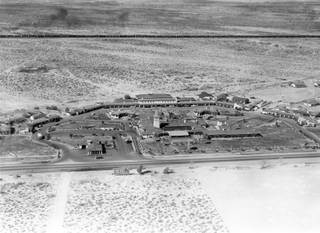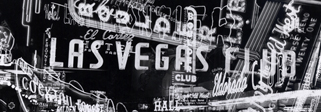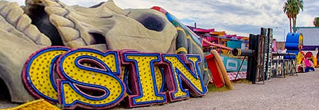Thursday, May 15, 2008 | 3 a.m.
Sun Archives
- Book examines 'The Man Who Invented Las Vegas' (2-15-2000)
- Strip casino industry counting on 'new' Vegas (10-15-1998)
- The Mirage opens its doors (11-23-1989)
- $15 Million Tropicana Hotel Opens Today (4-3-1957)
- Beautiful Sahara is Jewel out of fairyland (10-7-1952)
A small slice of the once humble Highway 91, a two-lane road that offered an arduous trip between Los Angeles and Salt Lake City, has become one of the most famous streets in the world: the Las Vegas Strip.
Changing from Highway 91 to Fifth Street to the current Las Vegas Boulevard, the Strip is where developers gambled and gamblers developed a habit of returning to numerous destination resorts.
Myths rampant in Las Vegas credit Benjamin “Bugsy” Siegel with creating the Strip. Even the film “Bugsy” leads viewers to think the gangster invented the Flamingo Hotel.
Wrong.
That honor belongs to William R. “Billy” Wilkerson, founder of the Hollywood Reporter and a serious gambler who imagined an American Monte Carlo. To that end he started building the Flamingo.
In the book “The Man Who Invented Las Vegas,” Wilkerson’s son, W.R. Wilkerson III, tells how his father segued from gambling in Southern California — after that state restricted betting in 1939 — to owning a casino in Las Vegas.
Wilkerson plunked down $84,000 and bought 33 acres at the site of today’s Flamingo. His friend Joseph Schenk, then boss of 20th Century Fox who, along with Howard Hughes, had bailed him out of debt many times, had advised him: “Own the house.”
Siegel muscled his way into the resort with greed and money when Wilkerson’s finances began evaporating. At first, Wilkerson held 48 percent of the Flamingo shares, making him the most powerful shareholder in the project. That was before Siegel arrived on the scene.
Siegel drove to Las Vegas in a Cadillac with mobster Meyer Lansky. Lansky had had his eye on Nevada since the 1920s and soon after the state legalized gambling in 1931 he became a hidden partner in Reno casinos. “What I had in mind was to build the greatest, most luxurious hotel casino in the world and invite people from all over America — maybe the high rollers from all over the world — to come and spend their money there,” Lansky said. It was Lansky, not the dapper hit man Siegel, who envisioned what Las Vegas could become. Siegel, it turned out, nearly ran the Flamingo into the ground in 1946 before it became a posh resort.
Another pioneer is Tommy Hull, who opened a small hotel in 1941 named El Rancho Vegas. With 63 rooms and a casino, the resort catered to motorists away from downtown Las Vegas’ Block, known for its barrooms, brawls and broads. To call it the “red light” district on Fremont Street is putting it politely.
The Flamingo and El Rancho Vegas competed to provide good food, entertainment and inexpensive rooms to the high rollers arriving in Las Vegas.
How the Strip — which, by the way, is not within the city limits of Las Vegas — got its name comes from two different story streams.
Those who were born, raised and still live in Las Vegas heard that tourists who asked where the airport was were told by the locals pointing down Las Vegas Boulevard: “Follow that strip.”
Another story about naming the Las Vegas Strip, according to Michael Green, history professor at the College of Southern Nevada, involves Guy McAfee, who worked the vice squad by day, ran casinos by night and married a Los Angeles madam. McAfee said that Fifth Street reminded him of Hollywood’s Sunset Strip.
From its beginnings, the Strip attracted the likes of Frank Sinatra, Dean Martin, Sammy Davis Jr., Red Skelton, Jimmy Durante, Rosemary Clooney (George Clooney’s aunt), Ella Fitzgerald, Lena Horn and other popular entertainers.
In an attempt to get a leg up on the entertainment market in Las Vegas, the Dunes Hotel began to feature topless showgirls in “Minsky’s Follies,” inspiring other showrooms to do the same.
In the 1960s and ’70s the Rat Pack — Sinatra, Martin, Davis, Peter Lawford and Joey Bishop — put the Sands’ Copa Room on the map. Liberace, Elvis Presley, Ann-Margret, Danny Thomas, Diana Ross and countless others transformed Strip resorts and Las Vegas into “The Entertainment Capital of the World.”
In 1968 billionaire Kirk Kerkorian, the “father of the megaresort,” purchased the Flamingo. He began training staff for the off-Strip hotel the International, now the Las Vegas Hilton.
No longer did Las Vegas bet on booze, broads and bets to attract gamblers. The age of destination resorts arose as soon as dust clouds from each implosion subsided. Today’s resorts rely on more than solo stars and offer a buffet of restaurants, shops and even games for the kids.
Circus Circus, shaped like a circus tent when it opened in the 1960s, built and operated an adjacent amusement park in the 1990s, now called Adventuredome.
Kerkorian built the MGM Grand Hotel and Theme Park at the south end of the Strip.
The Mirage featured magicians and animal trainers Siegfried & Roy in the showroom and built a white tiger habitat and a dolphin water park.
The Bellagio offers an art gallery and an indoor garden with themes that change with the seasons.
Without leaving the Strip, tourists can visit an Egyptian pyramid (Luxor), the Eiffel Tower (Paris Las Vegas), the Big Apple (New York-New York) or Camelot (Excalibur).
Stars and showgirls are fading, but major productions such as Cirque du Soleil, the Blue Man Group and others continue to shape the Strip into one of the most dynamic and entertaining streets in the world.
Intern Bethany Acree contributed to this story.
Sources: The Green Felt Jungle by Ed Reid and Ovid Demaris; The Money and the Power by Sally Denton and Roger Morris, Resort City in the Sunbelt by Eugene P. Moehring.


 Explore Las Vegas’ past and present
Explore Las Vegas’ past and present Boomtown: The Story Behind Sin City
Boomtown: The Story Behind Sin City Neon Boneyard: A 360° look
Neon Boneyard: A 360° look Mob Ties: See the connections
Mob Ties: See the connections Implosions: Classic casinos crumble
Implosions: Classic casinos crumble